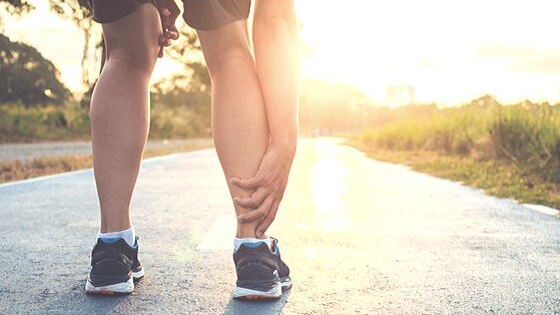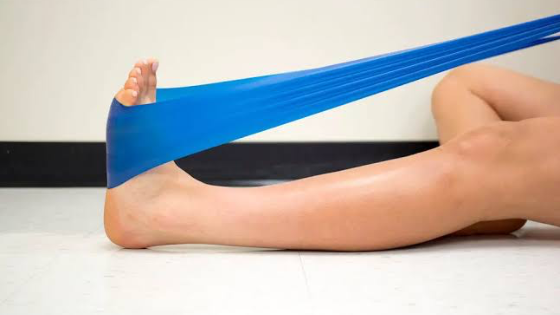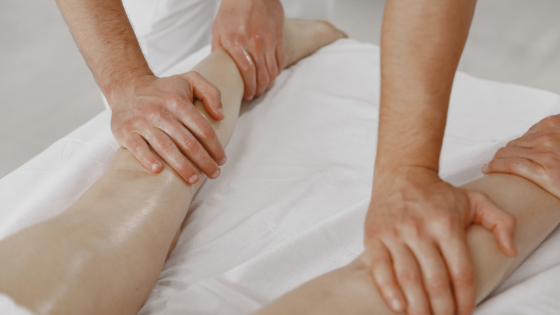If you’re exercising with lots of running or impact on the ankles and knees you may be experiencing shin and/or calf pain. Read on to find out more about shin splints or compartment syndrome.
Shin Splints
Shin splints, a common term used amongst the athletic community, describes chronic shin pain resulting from overuse. It can occur in two regions of the leg. When it occurs in the front outside region of the leg, it’s called anterior shin splints. Shin splints is also regularly seen in the lower inner region of the leg, where it’s called posterior shin splints or medial tibial stress syndrome (MTSS). Anterior shin splints is routinely confused with another overuse condition of the lower leg called chronic extertional compartment syndrome.
Anterior shin splints usually result from overuse of the muscles the flex the foot down, for example, the muscles used when running downhill. The condition usually occurs after continual repetitive use or sudden onset or increase of use. Most complain of the pain occurring at the beginning of exercise and then easing with use, only to return after stopping, even hours after.
What causes shin splints?
Anterior shin splints is usually an imbalance of the muscles of the calves and muscles of the front of the leg, usually afflicts beginners or runners who do not stretch enough. It is more likely to afflict the foot of the dominant side. For example, right handed people are more likely to suffer shin splints in their right leg.
Frequent cause of MTSS is over pronation, inadequate stretching, worn shoes or excessive stress placed on one leg from running in one direction, such as on a track.
It is suggested that during overuse the muscle separates itself from the shin bone, which results in inflammation and pain.
How to treat shin splints?
Rest
Firstly you need to rest. Stop what is causing the pain, ice your shin to reduce the pain and inflammation. Start some rehabilitation such as stretching and strengthening exercises after you have rested. Over-training or not addressing the issue as it arrises, may lead to serious injury.
Exercises
Ankle flexes, with bent knee and straight knee
Seated on the floor, use a theraband wrapped around the foot to flex the ankle forward. Do this first with a bent knee, and then with a straight knee
Toe flexes
Seated on the floor with a straight leg, wrap the theraband around the toes and flex forward
Ankle rotations
Seated on the floor with a straight leg, wrap the theraband around the sole of the foot and rotate the foot. Do this in both directions.
Heel & toe walk
First walk on your heels on a soft surface (carpet) for 25metres. Then walk back on your toes.
Standing calf raises
Standing on a step, raise up onto your toes and hold for 10 seconds. When you come down, go past the level of the step so your heel dips down. Do ten of these.
Standing toe raises
Leaning against a wall, raise your toes up, so you’re on your heels. Hold for a few seconds.
Or you can perform a simple toe tap, this can be done anywhere, anytime.
Glutes, core and pelvic strengthening
Any glute, core or pelvic strengthening will help take added pressure of the legs.
Stretches and massage
Stretching can increase range of movement and help reduce any tension that may be causing your pain. It’s not always the cause but is an important part of recovery process.
Front of shin stretch
Kneel on the ground and sit back on your heels. Stretch the front of your shins. Hold for 15 seconds. If this is too strong, stand, with the top surface of your toes on the floor, stretching the front of your shin
Calf stretch
Keep your knee straight and place your toes to the edge of a platform. Feel the stretch in the calf and the bottom of the foot. Hold for 15 seconds.
Achilles stretch
Follow the same steps and bend your knee to target the stretch to achilles and lower calf. Hold for 15 seconds.
Hip flexor stretch
Start by standing straight, bend your knee forward and step straight back to the ball of your foot. Keep your hips even and hold the stretch for 20 seconds.
Knee to chest
Laying flat on your back, bring the right knee toward the chest as far in as possible. Hold for 15 seconds. Repeat with the other leg.
Foam roller techniques for calf and shins (go easy on the foam roller, as this can be quite painful)
When treating shin splints I would use a combination of myofascial release, cupping and/or dry needling, and some trigger point therapy and deep tissue massage.
Wear the correct footwear
Being fitted for the correct footwear for you can make all the difference.
Avoid hard running surfaces
Hard surfaces have greater impact on your body and can cause trauma to the shins. Dirt, grass or unpaved surfaces are better than the footpath or road.
Also add variety to your training, as repetitive motion, such as running on a track in the same direction can add stress to your body.
Strengthen core and glute muscles
This will take further pressure off the muscles of the lower leg by being able to balance and control your legs more effectively .
There are various other supportive methods for shin splints such as, tapping, compression sleeves, ice and heat treatments. It’s best to see your physical therapist to help you with these treatments, to learn the best techniques on how to use them.
Compartment Syndrome
Fascia surrounds all our muscles and groups of muscles in compartments. Compartment Syndrome is increased pressure of fluid within the body’s compartments that contain muscles and nerves. Most commonly occurs in the lower leg and can often be misdiagnosed as shin splints. Chronic Exertional Compartment Syndrome is what most runners experience. It is induced by overuse and exercise where the pressure in the muscles increase to extreme levels. This creates a decrease in blood-flow and deprivation of oxygen to the muscle.
Symptoms include sensation of extreme tension in the muscle and burning increasing through exercise. The pressure usually decreases after exercise has stopped and the pain will be relieved.
Chronic or chronic exertional compartment syndrome are not emergency situations but can cause permanent damage to the muscle and nerve function of the limb.
How to treat compartment syndrome
Conservative treatment to reduce the pressure includes rest, anti-inflammatory medications and manual decompression such as myofascial release.
Do not elevate the limb or apply pressure to the area. Instead lie with the limb at the level of the heart. Massage can help once the inflammation has gone down.
Invasive treatment such as surgery can be an effective for sufferers of compartment syndrome.
ALM Remedial offers massage and myotherapy treatments for compartment syndrome and shin splints to the Yarra Valley, Lilydale and Dandenong Ranges areas.





